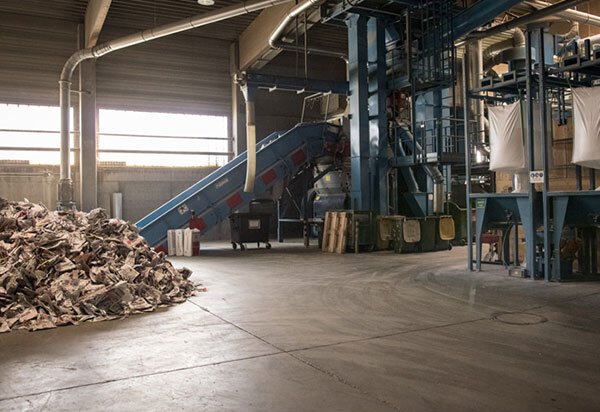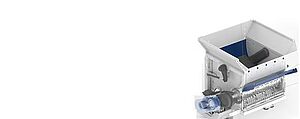When Newspapers Become High-Quality Insulation Material
The special way to recycle paper: the Peter Seppele Gesellschaft m.b.H. uses newspapers to produce the premium product Thermofloc at its Feistritz premises. And the Lindner Recyclingtech single shaft shredder Micromat 2000 has proven to be the ideal technology to guarantee the high-quality results needed. The stationary machine shreds four to six tons of single-origin newspapers per hour to a grain size of less than 60 millimetres.
Seppele is one of Lindner’s oldest clients in Austria. The business relationship dates back to the year 1993 when the two companies were neighbours with their production facilities in Feistritz an der Drau, Austria.
It was at that time, as CEO Ing. Mag. Peter Seppele explained in an interview, that Seppele bought the first large shredder made by Lindner. Today the family-run business is in its fourth generation with three sites in Carinthia, approximately 195 employees and around €38 million annual sales, and operates three Lindner shredders, including since 2010 the Micromat 2000 single shaft shredder for Thermofloc production. The stationary tried-and-tested machine by Lindner Recyclingtech has proven to be the ideal shredding solution for turning single-origin newspapers into high-class cellulose insulation material.

‘It’s all about preserving resources.’
Founded as a transportation company in 1929, the Peter Seppele Gesellschaft m.b.H. has been in the waste management sector since 1971 and has contributed to new ways of thinking in the industry. Peter Seppele’s father – who shares the same name as his son – ran the business until nine years ago and was the head of the company for more than 40 years; he continues to be held in high regard by the Austrian waste management industry as an environmental pioneer. ‘It’s all about preserving resources,’ is Peter Seppele’s summary of his company’s philosophy in this regard. ‘That’s what motivates us every single day: we avoid waste and collect the by-products of our customers’ manufacturing processes as soon as possible to turn them into something useful.’ It was in 1996 that the production and sale of Thermofloc started, the cellulose insulation material made of shredded newspapers. And since 1998 the company has also produced impact sound insulation material from paper pallets and turned wood pellets into fuel.
From inspecting the incoming goods to the final product
The material used to produce insulation material is bought by type on the open market and is mostly transported to the facility by lorry from Italy. According to Thermofloc division manager Mag. Heimo Krainer’s description of the production process, after inspection upon arrival the newspapers are temporarily put into storage. The newspaper bundles are then taken from the temporary storage by forklift, cut open by Seppele workers, checked and fed into the Micromat by conveyor belt – a chain conveyor – and shredded to a grain size of 90% less than 60 millimetres. Subsequently, the material is fed into fibre grinders and mixed with additional components in the drying process. The final product is loose cellulose insulation material ready for use, which only has to be packed and is then ready for sale. At Seppele, that task is done by robots.
Thermofloc is approved for use throughout Europe and is currently sold in 18 countries. According to Peter Seppele, this organic insulation material has the same properties as glass or mineral wool, but its ecological benefits set it apart. ‘It’s a natureplus-certified recycled product which insulates buildings perfectly.’ Applied by machine using the Thermablow method, it is easy to create waste-free cavity wall or spray-on insulation for roofs, floors and walls.
Lives up to expectations
The Lindner Micromat 2000’s shredding performance is crucial to meeting the quality standards of a premium product. As Heimo Krainer agrees. Why did Seppele decide to buy this machine from Lindner? ‘Because, compared to other machines, this was the one that most closely lived up to our expectations.’ The shredder runs continuous shifts around the clock, and normally does so seven days a week. The throughput stands at four to six tons of newspapers an hour and the wear and tear on the knives and counter knives is minimal according to the specifications. So far, the company is happy with the standard machine with standard components. And as they say, the knives are a perfect blend of rigidity and flexibility.
In practice, the hydraulic maintenance flap to quickly remove foreign parts and access the rotor has proven just as valuable as the movable screen system to unproblematically replace the screen and internal ram system, guaranteeing higher filling volumes and avoiding unnecessary material leakage. The company can perform 80% of all maintenance work themselves; the Lindner service team is only called if something needs to be replaced – and that hardly ever happens at Seppele.
In terms of energy consumption, CEO Peter Seppele and Thermofloc division manager Heimo Krainer cannot give any specific numbers, but they rely on their long-term experience as a customer: in general, they know that Lindner manufactures cost-efficient machines in all aspects and is always a market pioneer in terms of developing innovative drive concepts. Our visit to the Seppele company ended with personal anecdotes about a stray old car door and obsolete shilling bank notes which had to be shredded and repurposed after Austria adopted the Euro. But that’s another story altogether...

